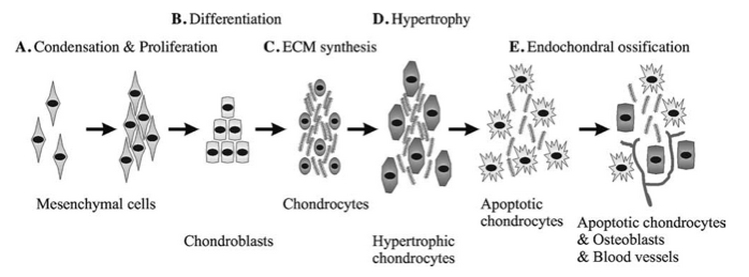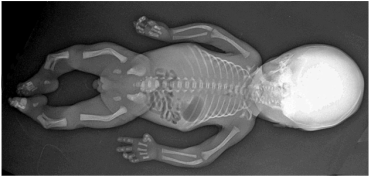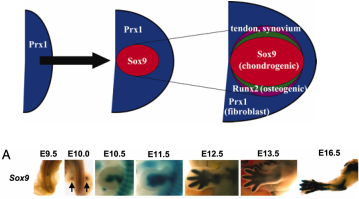An Introduction to Sox9 and Campomelic Dysplasia
Sox9 (SRY-Box Containing Protein 9), is a gene located on the human chromosome 17 (location 17q23). It encodes a transcription factor that recognizes the sequence CCTTGAG along with other members of the HMG-box class DNA-binding proteins. It acts during chondrocyte differentiation and, when interacting with steroidogenic factor 1, regulates transcription of the anti-Muellerian hormone (AMH) gene during sexual development, among others. Deficiencies lead to the skeletal malformation syndrome Campomelic Dysplasia, frequently with sex reversal (Wagner et al 1994; Foster et al 1994).
Campomelic dysplasia is a disorder of the newborn characterized by congenital bowing and angulation of long bones, together with other skeletal and extraskeletal defects (See X-Ray figure to the right for an example; provided by http://www.ncbi.nlm.nih.gov/books/NBK1760/ ). Up to two-thirds of affected XY individuals have a gradation of genital defects or may develop as phenotypic females (Wagner et al 1994).
Sox9 haploissuficient mutant mice have defective cartilage primordia and results in premature skeletal mineralization and are used as a model for Campomelic Dysplasia (Bi et al 2001). It is also a convenient and well used molecular marker in developmental studies to show mesenchymal condensations,as well as the developing cartilage tissue in the early limb bud (Akiyama et al 2005--see fig A on right to see developmental progression in the embryonic limb). The a model of Sox9 in chondrogenesis (in the context of the limb bud) is shown in the figure to the right.
Cartilage differentiation and Endochondral Ossification: Processes that are regulated by Sox9

Steps of Endochondral Bone Development. (Quintana et al 2009)
To put Sox9's role in development into perspective, I will describe the developmental process of skeletal development Sox9 is involved in. The development of the long bones in vertebrates is a process known as endochondral ossification (see figure above and its accompanying review in Quintana et al 2009), which is a process of bone development that the mesenchymal precursors must go thru a cartilage intermediate, which then bone replaces. Endochondral bone development begins when the mesenchyme cells condense and proliferate to form a scaffolding structure of the skeleton that has been patterned in processes preceding it. Signals instruct these cells to differentiate into chondroblasts. These chondroblasts then subsequently synthesize and secrete extracellular matrix components specific to cartilage, which then causes these cells to differentiate into mature chondrocytes. These chondrocytes then stop proliferating and undergo hypertrophic differentiation (which includes mineralization of the cartilage matrix with calcium salts and changing the overall composition of the ECM components) into what are called hypertrophic chondrocytes. These hypertrophic chondrocytes undergo apoptosis upon blood vessel invasion. The blood vessels carry osteoblasts, which begin to invade the tissue and begin to form bone using the cartilaginous matrix as a scaffold/template and replaces it by mineralized matrix.
Sox9 is known to be expressed from the mesenchymal condensations all the way until hypertrophic differentiation, where Sox9 and Col2a1 is downregulated, while Runx2 and ColX expression is upregulated (Provot and Schipani 2005). Sox9 has been shown to be a master regulator of the differentiation of chondrocytes in endochondral bone development: Conditional inactivation studies has shown that Sox9 is necessary for mesenchymal condensations, chondrocyte lineage commitment at the time where the osteochondroprogenitors 'decide' whether to become chondrocytes or osteoblasts, and for the overt differentiation of these cells into chondrocytes (Kist et al 2002; Akiyama et al 2002). It is also important to note that Sox9 needs to dimerize with itself in order to properly regulate chondrogenesis, but is not needed for its role in other processes like sex determination (Bernard et al 2003). It has also been shown that Sox9 is sufficient for ectopic cartilage formation in chick limb buds (Healy et al 1999).
References
Wagner, T., Wirth, J., Meyer, J., Zabel, B., Held, M., Zimmer, J., Pasantes, J., Dagna Bricarelli, F., Keutel, J., Hustert, E., Wolf, U., Tommerup, N., Schempp, W., Scherer, G. Autosomal sex reversal and campomelic dysplasia are caused by mutations in and around the SRY-related gene SOX9. Cell 79: 1111-1120, 1994.
Foster, J. W., Dominguez-Steglich, M. A., Guioli, S., Kwok, C., Weller, P. A., Stevanovic, M., Weissenbach, J., Mansour, S., Young, I. D., Goodfellow, P. N., Brook, J. D., Schafer, A. J. Campomelic dysplasia and autosomal sex reversal caused by mutations in an SRY-related gene. Nature 372: 525-530, 1994.
Bi, W., Huang, W., Whitworth, D. J., Deng, J. M., Zhang, Z., Behringer, R. R., de Crombrugghe, B. Haploinsufficiency of Sox9 results in defective cartilage primordia and premature skeletal mineralization. Proc. Nat. Acad. Sci. 98: 6698-6703, 2001.
http://www.ncbi.nlm.nih.gov/books/NBK1760/
Haruhiko Akiyama‡, Jung-Eun Kim‡, Kazuhisa Nakashima, Gener Balmes, Naomi Iwai, Jian Min Deng, Zhaoping Zhang, James F. Martin, Richard R. Behringer, Takashi Nakamura, and Benoit de Crombrugghe. Osteo-chondroprogenitor cells are derived from Sox9 expressing precursors. PNAS 2005 102 (41) 14665-14670
Quintana L, zur Nieden NI, Semino CE. Morphogenetic and regulatory mechanisms during developmental chondrogenesis: new paradigms for cartilage tissue engineering. Tissue Eng Part B Rev. 2009 Mar;15(1):29-41.
Provot S, Schipani E. Molecular mechanisms of endochondral bone development. Biochem Biophys Res Commun. 2005 Mar 18;328(3):658-65.
Kist R, Schrewe H, Balling R, Scherer G. (2002). Conditional inactivation of Sox9: a mouse model for campomelic dysplasia. Genesis 32: 121-123
Akiyama H, Chaboissier MC, Martin JF, Schedl A, de Crombrugghe B. (2002). The transcription factor Sox9 has essential roles in successive steps of the chondrocyte differentiation pathway and is required for expression of Sox5 and Sox6. Genes Dev 16: 2813-2828
Bernard P, Tang P, Liu S, Dewing P, Harley VR, et al. (2003) Dimerization of Sox9 is required for chondrogenesis, but not for sex determination. Hum Mol Genet 12: 1755-1765
Healy C, Uwanogho D, Sharpe PT. Regulation and role of Sox9 in cartilage formation. Dev Dyn. 1999 May;215(1):69-78.
Foster, J. W., Dominguez-Steglich, M. A., Guioli, S., Kwok, C., Weller, P. A., Stevanovic, M., Weissenbach, J., Mansour, S., Young, I. D., Goodfellow, P. N., Brook, J. D., Schafer, A. J. Campomelic dysplasia and autosomal sex reversal caused by mutations in an SRY-related gene. Nature 372: 525-530, 1994.
Bi, W., Huang, W., Whitworth, D. J., Deng, J. M., Zhang, Z., Behringer, R. R., de Crombrugghe, B. Haploinsufficiency of Sox9 results in defective cartilage primordia and premature skeletal mineralization. Proc. Nat. Acad. Sci. 98: 6698-6703, 2001.
http://www.ncbi.nlm.nih.gov/books/NBK1760/
Haruhiko Akiyama‡, Jung-Eun Kim‡, Kazuhisa Nakashima, Gener Balmes, Naomi Iwai, Jian Min Deng, Zhaoping Zhang, James F. Martin, Richard R. Behringer, Takashi Nakamura, and Benoit de Crombrugghe. Osteo-chondroprogenitor cells are derived from Sox9 expressing precursors. PNAS 2005 102 (41) 14665-14670
Quintana L, zur Nieden NI, Semino CE. Morphogenetic and regulatory mechanisms during developmental chondrogenesis: new paradigms for cartilage tissue engineering. Tissue Eng Part B Rev. 2009 Mar;15(1):29-41.
Provot S, Schipani E. Molecular mechanisms of endochondral bone development. Biochem Biophys Res Commun. 2005 Mar 18;328(3):658-65.
Kist R, Schrewe H, Balling R, Scherer G. (2002). Conditional inactivation of Sox9: a mouse model for campomelic dysplasia. Genesis 32: 121-123
Akiyama H, Chaboissier MC, Martin JF, Schedl A, de Crombrugghe B. (2002). The transcription factor Sox9 has essential roles in successive steps of the chondrocyte differentiation pathway and is required for expression of Sox5 and Sox6. Genes Dev 16: 2813-2828
Bernard P, Tang P, Liu S, Dewing P, Harley VR, et al. (2003) Dimerization of Sox9 is required for chondrogenesis, but not for sex determination. Hum Mol Genet 12: 1755-1765
Healy C, Uwanogho D, Sharpe PT. Regulation and role of Sox9 in cartilage formation. Dev Dyn. 1999 May;215(1):69-78.


